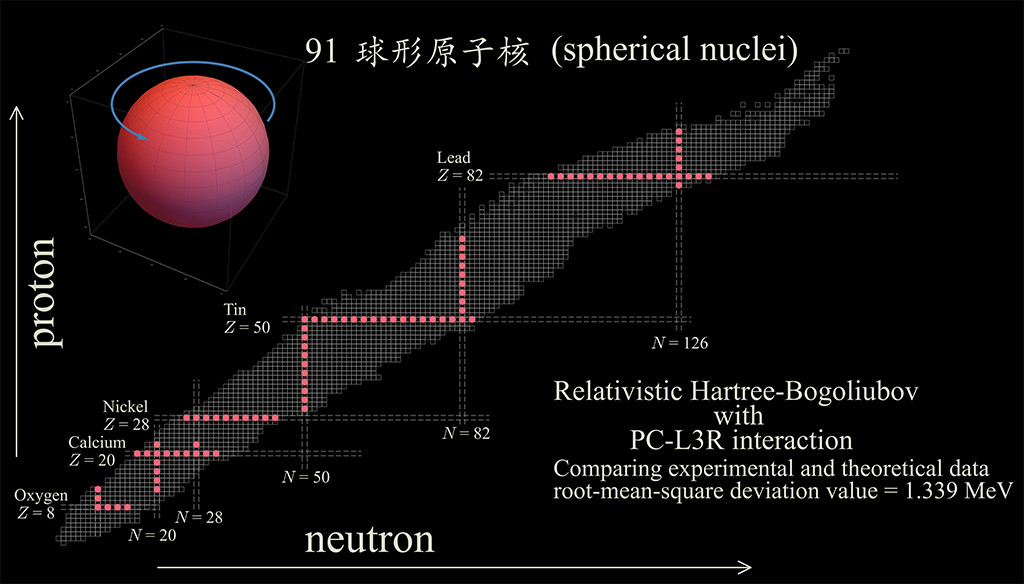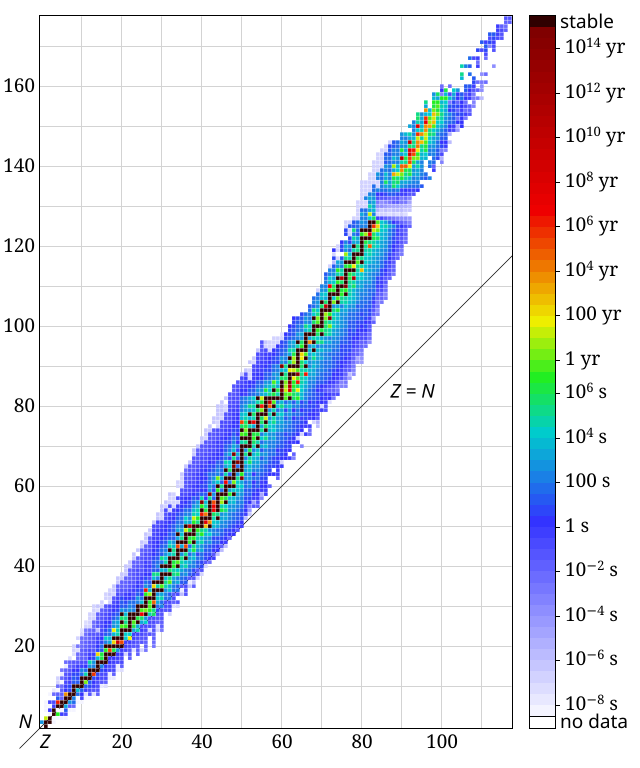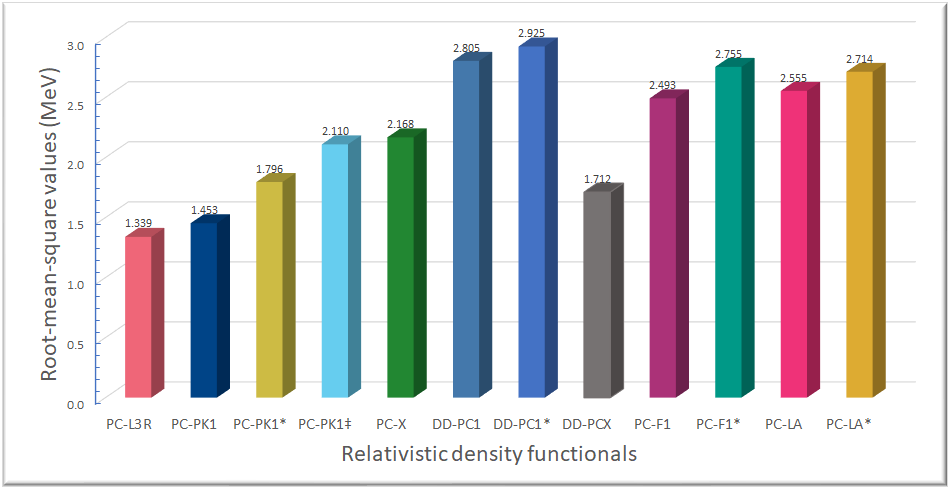Covariant Density Functional Theory
“Everyone has a story. It might or might not be a love story. It could be a story of dreams, friendship, hope, survival or even death. And every story is worth telling. But more than that, it’s worth living.” Savi Sharma, Everyone Has A Story
“Every nuclear species has a story. Among the subatomic particles, it is the in-medium NN interaction. It could be a story of many interactions, short lives, or decays. And every study of these phenomena is worth telling. But more than that, it's worth surfing.” Yi Hua Lam

Figure 1. The 91 spherical nuclei (red dots) are plotted against the nuclear chart consisting of all experimentally discovered nuclei (background squares). For more details see Physics Letters B 842, 137946 (2023). (Image Credit: LU Ning and LAM Yi Hua)
New experiments based on the recent advancements in radioactive ion beams and detectors reveal a wealth of structural phenomena in exotic nuclei. These exotic nuclei are those atomic nuclei having more neutrons than protons or vice versa. These nuclei are far from the region of stability in the sense that they are unstable against the beta decay. In other words, their half-lives are short and could be highly radioactive. Therefore, having theoretical nuclear models capable of describing the properties of these exotic nuclei far from the region of stability is crucial for us to understand the interactions and configurations of nucleons in the exotic nuclei, to guide future experiments, and to predict the radioactive decays of exotic nuclei.
 |
|---|
| Figure 2. The half-lives of nuclei determined in various experiments (Wikipedia). The x-axis is proton number, Z, whereas the y-axis is neutron number, N. The stable isotopes deviate from the Z = N line as Z increases causing stronger repulsive Coulomb force, and thus more neutron are needed to increase the attractive strong nuclear force. Image credit: BenRG. |
The covariant density functional theory is one of the most successful models for the study of nuclear structure. The relativistic Hartree-Bogoliubov (RHB) framework is categorized as a covariant density functional theory. RHB takes relativistic effect in the nucleon-nucleon interactions into account. The covariant density functional theory provides the advantage of the natural inclusion of the nucleon spin degree of freedom. Moreover, the consistent treatment of isoscalar Lorentz-scalar and -vector self-energies, permits a unique parametrization of time-odd components of the nuclear mean field. Furthermore, we can get a natural explanation of the empirical pseudospin symmetry, and a distinction between scalar and four-vector nucleon self-energies for a new saturation mechanism of nuclear matter.
Recently, we deduced a point-coupling interaction for the relativistic Hartree-Bogoliubov (RHB) framework. The newly optimized point-coupling interaction is acronymized as PC-L3R interaction. In this work, we had taken more observables into account for optimizing the point-coupling interaction compared with all previous point-coupling interactions. These observables consist of the binding energies of 91 spherical nuclei, charge radii of 63 nuclei, and 12 sets of mean pairing gaps consisting of 54 nuclei in total. Meanwhile, in order to better reproduce the experimental odd-even oscillations of the binding energies of nuclei, we further optimized the separable proton and neutron pairing strengths together with the point-coupling interaction. According to Peter Ring, the professor emeritus of Technische Universität München, who participated in this research project, the results of the fit for the pairing strength show that the effective pairing-constant for the protons is smaller than that for the neutrons. This could be connected with the fact that the repulsive contribution of the Coulomb force to the pairing correlations reduces the size of the effective attractive pairing strength for protons.
|  |
|:–:|
| Figure 3. The root-mean-square deviation values of comparing the experimental and theoretical binding energies of 91 spherical nuclei. Among the commonly used point-coupling interactions, the PC-L3R interaction yields the set of theoretical binding energies closest to the experimental data. For more details see Physics Letters B 842, 137946 (2023). (Image credit: LAM Yi Hua) |
|
|:–:|
| Figure 3. The root-mean-square deviation values of comparing the experimental and theoretical binding energies of 91 spherical nuclei. Among the commonly used point-coupling interactions, the PC-L3R interaction yields the set of theoretical binding energies closest to the experimental data. For more details see Physics Letters B 842, 137946 (2023). (Image credit: LAM Yi Hua) |
The results indicate that the newly optimized point-coupling interaction, with the acronym PC-L3R, is able to predict the best description on the experimentally determined binding energies of 91 spherical nuclei among all point-coupling interactions (Fig. 3). Moreover, the calculated charge radii of 63 nuclei satisfactory agree with the respective experimental findings. We expect the PC-L3R interaction is capable of describing the properties of exotic nuclei and of guiding future experiments. These properties include the binding energies, radioactive decays, and radii, of which can be measured in future advanced experiments. In addition, the PC-L3R point-coupling interaction provides a reliable alternative set of references for future studies based on the covariant density functional theory.
Publications
-
Z. X. Liu, Y. H. Lam, N. Lu, P. Ring, Nuclear ground-state properties probed by the relativistic Hartree-Bogoliubov approach, Atomic Data and Nuclear Data Tables 156, 101635 (2024)
-
Z. X. Liu, Y. H. Lam, N. Lu, P. Ring, The optimized point-coupling interaction for the relativistic energy density functional of Hartree-Bogoliubov approach quantifying thenuclear bulk properties, Physics Letters B 842, 137946 (2023)